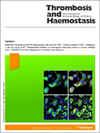转移核糖核酸与终末期肾病患者缺血性中风和大出血有关。
IF 5
2区 医学
Q1 HEMATOLOGY
引用次数: 0
摘要
背景终末期肾病(ESKD)患者血栓栓塞和出血的风险非常高。本研究旨在确定小非编码 RNA(sncRNA),特别是 microRNA 和转运核糖核酸(tRNA)衍生片段(tRF),作为预测这一高风险人群血栓栓塞和出血的潜在新型生物标志物。方法在这项 sncRNA 发现研究中,我们利用由 625 名接受血液透析的 ESKD 患者组成的 VIVALDI 队列开展了两项巢式病例对照研究,每项研究由 18 名参与者组成。第一项研究的主要结果是缺血性中风,第二项研究的主要结果是大出血。使用 miND 管道处理血浆样本,进行 RNA-seq 分析,研究病例与各自匹配的对照组之间 microRNA 和 tRNA/tRFs 的差异表达,并对结果进行严格的假发现率 (FDR) 调整。但是,与对照组相比,我们发现缺血性中风病例中有 4 个 tRNAs、大出血病例中有 7 个 tRNAs 有明显差异表达(FDR<0.1)。不过,覆盖图显示检测到的是特定的 tRNA 片段(tRF),而不是全长 tRNA。替代的图谱绘制方法揭示了一些挑战和技术限制,从而无法对这些特定的 tRFs 进行深入的差异表达分析。结论虽然 microRNAs 没有显示出显著的差异表达,但我们的研究发现了特异性 tRNAs/tRFs 作为 ESKD 患者缺血性中风和大出血的潜在新型生物标记物的潜力。.本文章由计算机程序翻译,如有差异,请以英文原文为准。
Transfer RNAs are linked to ischemic stroke and major bleeding in patients with end-stage kidney disease.
BACKGROUND
Patients with end-stage kidney disease (ESKD) are at very high risk for thromboembolism and bleeding. This study aimed to identify small non-coding RNAs (sncRNAs), specifically microRNAs and transfer-RNA (tRNA)-derived fragments (tRFs), as potential novel biomarkers for predicting thromboembolism and bleeding in this high-risk population.
METHODS
In this sncRNA discovery research, we leveraged the VIVALDI cohort, consisting of 625 ESKD patients on hemodialysis, to conduct two nested case-control studies, each comprising 18 participants. The primary outcomes were ischemic stroke in the first study and major bleeding in the second. Plasma samples were processed using the miND pipeline for RNA-seq analysis to investigate differential expression of microRNAs and tRNA/tRFs between cases and their respective matched controls, with results stringently adjusted for false discovery rate (FDR).
RESULTS
No significant differential expression of microRNAs for either ischemic stroke or major bleeding outcomes was observed in the two nested case-control studies. However, we identified four tRNAs significantly differentially expressed in ischemic stroke cases and seven in major bleeding cases, compared to controls (FDR<0.1). Coverage plots indicated that specific tRNA fragments (tRFs), rather than full-length tRNAs, were detected, however. Alternative mapping approaches revealed challenges and technical limitations that precluded in-depth differential expression analyses on these specific tRFs. Yet, they also underscored the potential of tRNAs and tRFs as markers for thromboembolism and bleeding.
CONCLUSION
While microRNAs did not show significant differential expression, our study identifies specific tRNAs/tRFs as potential novel biomarkers for ischemic stroke and major bleeding in ESKD patients. .
求助全文
通过发布文献求助,成功后即可免费获取论文全文。
去求助
来源期刊

Thrombosis and haemostasis
医学-外周血管病
CiteScore
11.90
自引率
9.00%
发文量
140
审稿时长
1 months
期刊介绍:
Thrombosis and Haemostasis publishes reports on basic, translational and clinical research dedicated to novel results and highest quality in any area of thrombosis and haemostasis, vascular biology and medicine, inflammation and infection, platelet and leukocyte biology, from genetic, molecular & cellular studies, diagnostic, therapeutic & preventative studies to high-level translational and clinical research. The journal provides position and guideline papers, state-of-the-art papers, expert analysis and commentaries, and dedicated theme issues covering recent developments and key topics in the field.
 求助内容:
求助内容: 应助结果提醒方式:
应助结果提醒方式:


